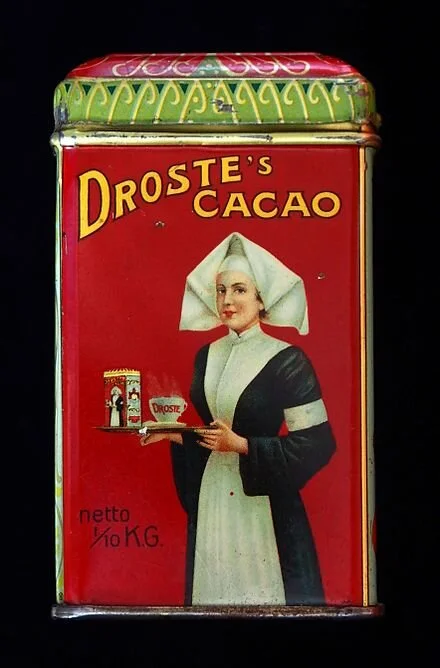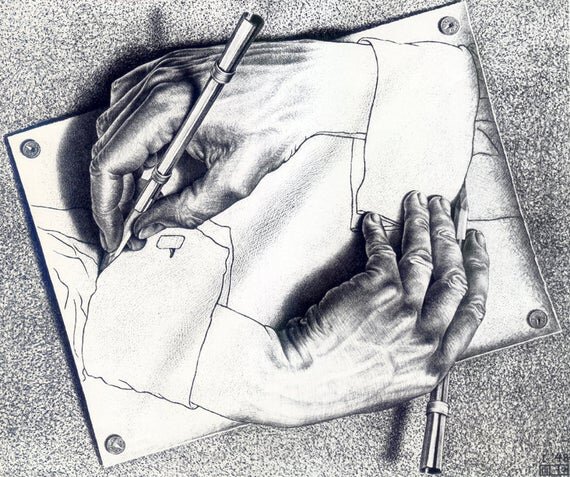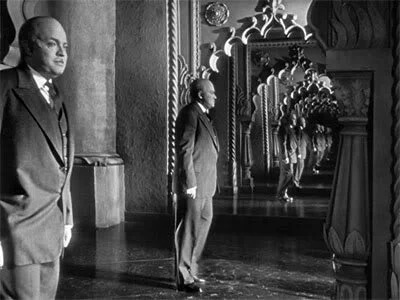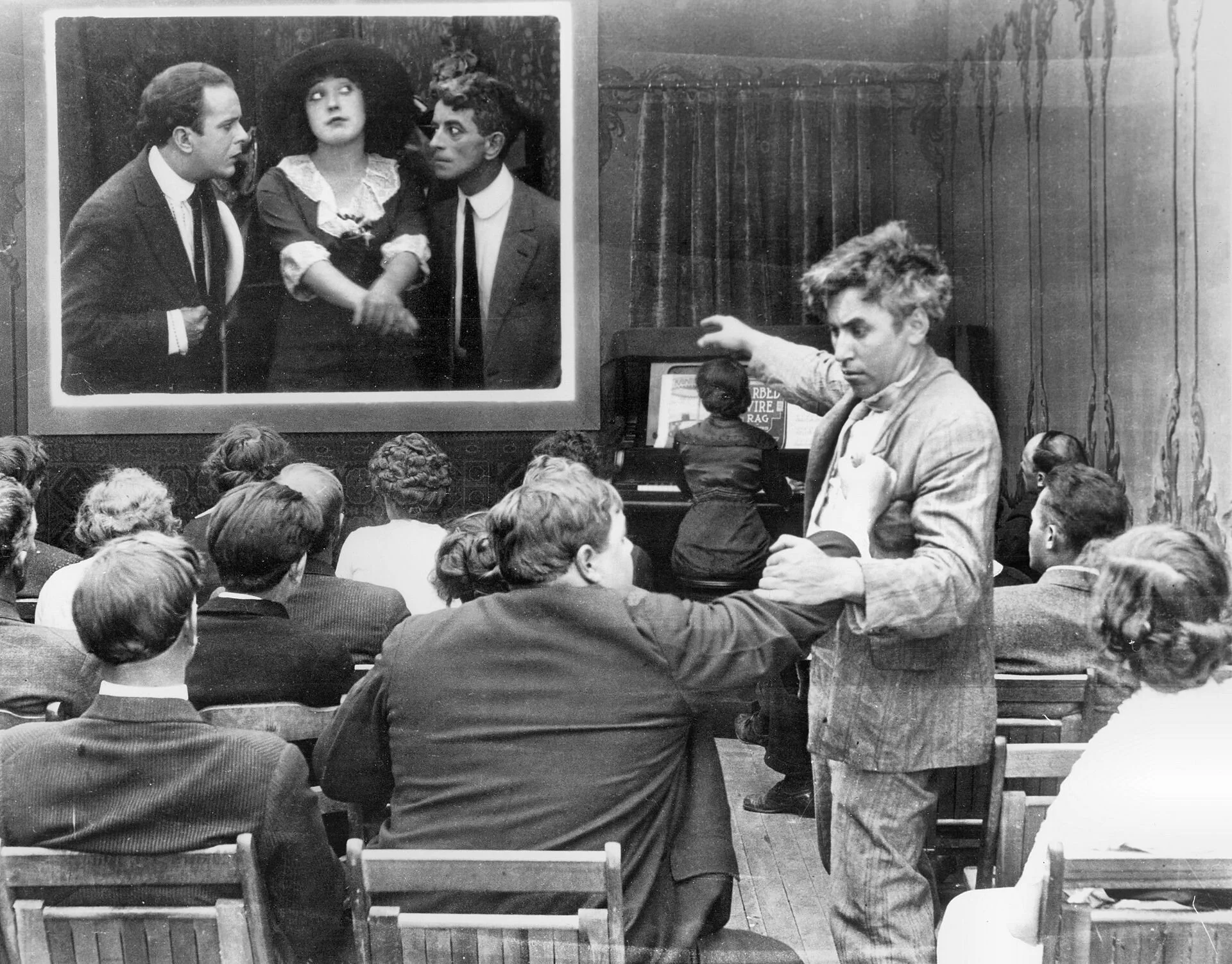By The Landlord
“Anything you can do, I can do meta.” – Rudolf Carnap
“A mirror mirroring a mirror.” – Douglas R. Hofstadter, I Am a Strange Loop
What am I writing now? Well, it looks like I’m already embarking on a second sentence that is heading towards the definition of this topic, so I’d better get on with it. ‘Meta’ means – in this context – a piece of creative work, namely a song, that refers to itself or to the conventions of its genre. Yeah, that’s more like it, and so, with the third sentence having made some headway, now it’s time for the fourth to press the play button.
This sentence is already imagining that drum beat, and, it sounds like that’s the bass coming in – hey, catchy – that’s a nice riff. And next, the guitar, now slipping smoothly through a pleasing chord sequence that completes its first cycle back to the tonic key. And finally, here’s the singer with the first line of lyrics and going straight into the verse. It all sounds interesting, but when are we heading for the chorus so I can really get into the swing of this number, hear the hook and the punchline and actual know the title of this song?
Meta songs are songs that are about and refer to themselves – and they can do that in all sorts of ways. But before we dive into all that, does this topic sound, or look familiar? Then you might be right, but also wrong. Back in the mists of time, if you open a very old and dusty page of the archives to which many of us refer when looking to suggest songs that haven’t come up in playlists before, you might find two faint echoes from the past, two topics that were explored by many different people, perhaps not those reading this right now, and a really fine music writer named Dorian Lynskey, who thought about self-referential songs and songs about songs. Dorian must have been really into this stuff because he did them both within a matter of months in 2006. But they weren’t quite the same.
But now that it’s 2021, and a lot can happen in 15 years, it’s not only high time we got back to this topic, but also because those two old playlists weren’t quite what we’re looking for anyway. Self-referential songs were ones in which the artist made mention of themselves, or at least their public persona. And songs about songs, which is closer to meta songs, mainly ended up his Dorian’s playlists, being about other songs, or genres. But meta songs are songs that are about themselves.
But how might you find a meta song? Where might you meet one? In lyrics, or title, the word ‘song’ and particularly ‘this song’ is a good place to start. The meta song works in lots of ways, and for a mirror-effect of referencing fun, I’ll throw in some lyrics by songs, without naming them, that may or may not have been listed for other topics. Feel free to track down the artists and nominate these, or others to help get you going.
These examples show the meta in a variety of ways. So to start, some might talk about what the song hopes to achieve:
“This song will be here when you're old
This song will heat you when you're co-old
Believe you when I don't
This song will heal you from your soul.”
Or more specifically it might refer to the emotions it might elicit:
“This is a weeping song
A song in which to weep
While all the men and women sleep.”
Or the definition might be more direct rather than just hopeful, saying what it is, or what is isn’t:
“This is not a love song”.
The meta song might also involve mentioning a third party for whom the song is, or isn't written about:
“You probably think this song is about you”.
Or:
“Where would I be now, where would I be now if we’d never met?
Would I be singing this song to someone else instead?”
Or say that the song is still looking for an unknown audience:
“I walked out this mornin’ and I wrote down this song,
I just can't remember who to send it to.”
Other meta songs might talk about what sort of song it might be, such as love song, a protest song, a ballad or a mention any genre in reference to itself. It might start off being about someone, but then become more universal:
“I started to write this song about you,
And then I decided it that I would write it all about love.”
Or even compare itself, in this case unfavourably, to the work of another artist:
“The only thing I did was write this stupid song about it.
If I was Leonard Cohen or some other song-writing master,
I'd know to first get the oral sex and then write the song after.”
Some songs might just offer up themselves, and hope that the listener likes it, sometimes with a slightly self-conscious, false modesty:
“I know it’s not much but it’s the best I can do,
My gift is my song and this one’s for you.”
And then there are songs that actually get into the musical nuts and bolts, such as when instruments are coming in and who might be playing them:
“Hearing from you later Casanova, on horn... yeah!`
Digging General de Gaulle on accordion... really wild, General! Thank you, sir
Roy Rogers on Trigger
Tune in Wild Man of Borneo on bongos
Count Basie Orchestra on triangle... thank you."
Or refer to more specific components of the music, perhaps starting with the process of how to choose a title:
“Write a song about your dream of horses,
Call it ‘Judy and the Dream of Horses’”
It might perhaps have a gentle dig at the co-writer, with a caustic wit:
"If you’re listening to this song,
You may think the chords are going wrong.
But they're not, he just wrote it like that.”
Or perhaps get referential into one, or even every part of the song structure:
“Damn, we the committee, gone burn it down,
But us gone bust you in the mouth with the chorus now …”
“And this is the chorus, or perhaps it’s a bridge
Or just another part of the song that I’m singing.”
And there are many more out there, and many ways that a meta-song can manifest itself, mirroring, parodying, referring, self-conscious, funny, clever, paranoid, specific and universal.
But when it comes to art self-referencing, there’s a whole other world of examples in other artforms that in some cases loop back to music. Here are a few examples that will hopefully help inspire this way of thinking for songs.
The mise en abyme in the old English coat of arms
And a wonderful area to start that of the mise en abyme, meaning in French, to put or place in the centre. It’s a central tenet of how meta-art works. Another word for this is inescutcheon. The abyme is originally an heraldic term pertaining to the centre part of a coat of arms, which is a replica echo of the larger part. Here’s an example in the British royal coat of arms for the period 1816–1837, as used by King George III. The crown of Charlemagne is placed en abyme within the escutcheon of Hanover, which in turn is en abyme within the arms of England, Scotland, and Ireland. In other words, it refers to itself within itself.Another example is the coat of arms of Russia, which holds a sceptre topped by a similar eagle holding a similar sceptre.
But there are many other more subtle examples in which reflections and smaller versions of the work itself appear, and when they do so ad infinitum, it’s known as the Droste effect. One of the earliest known examples is by Giotto in 1320, in his Stefaneschi Triptych. The polyptych altarpiece portrays in its center panel Cardinal Giacomo Gaetani Stefaneschi offering the triptych itself to St. Peter. And then there’s Jan Van Eyck’s famous Les époux Arnolfini of 1434, the Dutch oil painter’s depiction of an Italian merchant and his wife, with it’s extraordinary use of light and perspective, but in particular the mirror behind the two figures. Here it is with that special detail:
Jan Van Eyck’s Les époux Arnolfini of 1434
… and detail of the mirror within it
The Droste effect, where mirrors appear within mirrors, is named after another piece of Dutch artwork centuries later - an image on the tins and boxes of the traditional brand of Droste cocoa powder, originally designed by Jan Misset and released in 1904, after which it went through redesigns and variants with the same basic idea, a recursive pattern where the smaller version contains an even smaller version of the picture ad infinitum.
Tin … tin. The Droste effect, with the cacao label inside the cacao label …
This brand trick has since been used countless times, such as on Land O'Lakes butter, which featured a Native American woman holding a package of butter with a picture of herself, or Laughing Cow spreadable cheese (La Vache qui rit) featuring a cow with earrings that are really images of the circular cheese spread package, each bearing the image of the laughing cow.
Perhaps the most famous illustrative examples of the meta Droste effect in in the hands of yet another Dutch artist, M.C. Escher, who explored the idea ad infinitum, such as his Drawing Hands, or his Print Gallery, below shown in animated form, in which a man looks at a picture of himself looking at a picture in a gallery and so on.
Escher’s Drawing Hands
Animation of Escher’s Print Gallery
There are also many examples of the meta, mirrored self-reference in film and photography:
Citizen Kane above and Mabel’s Dramatic Career
The second image comes in Orson Welles’s Citizen Kane (1941), the third is Mabel’s Dramatic Career, a 1913 American short comedy film, featuring a film within a film and uses multiple exposure to show a film being projected in a cinema.
And there are many more recent films that have explored the idea of meta self-reference in a variety of entertaining and fiendishly clever ways. Woody Allen sets up many mesmirising plots of meta-reference, including, for example 1985’s The Purple Rose of Cairo, in which, Tom, a character in that film played by Jeff Daniels, noticing how Cecilia (Mia Farrow) who uses the cinema for escapism, has watching him from the cinema seat, and breaks the fourth wall, emerging from the inner film's black-and-white world into the full colour real world the other side of the cinema screen, with a series of ever complex ramifications as the actor who plays Tom also gets involved in the plot.
But perhaps the most meta of all screenwriters and directors is Charlie Kaufman, behind mind-bending self-referencing plots (often alongside director Spike Jonze) such as Being John Malcovich, in which the actor plays himself but other people enter a portal within him to experience his life, Adaptation, in which Nicholas Cage plays Kaufman, the depressed writer with a gauche twin brother, and Synecdoche, New York, in which there are plays within plays (as in Shakespeare’s Hamlet) but with Philip Seymour Hoffman as theatre director, reality and fiction intertwine endlessly.
And there are countless forms of the meta in literature. One of the best practitioners is Italo Calvino, who opens one book with:
“You are about the begin reading Italo Calvino’s If on a winter’s night a traveler. Relax, concentrate, dispel every other thought. Let the world around your fade. Best to close the door; the TV is always on in the next room …”
Or the fiendishly clever sci-fi writer: Phillip K Dick, who in Do Androids Dream of Electric Sheep?, the book on which Ridley Scott’s Blade Runner was based, writes:
“You mean old books?"`
"Stories written before space travel but about space travel."
"How could there have been stories about space travel before --"
"The writers," Pris said, "made it up. ”
And then there’s Russell Hoban’s 1967 children's novel, The Mouse and His Child, a wondrous maze of the meta that mirrors much in Lewis Carroll, and was made into an animated film 10 years later. In this clip, looping back to the earlier brand material already mentioned, an attempt is made to count the dogs on a recurring label on a can of Bonzo Dog Food:
And how more meta can this example be that in The Simpsons, in which a meme of Homer melting into a bush (itself a reference to the shapeshifting T-1000 in Terminator 2) from a previous episode is not only shown but also referenced in a social media post commented on by two musicians.
A Simpson meta maze of self-reference in a musical context
The meta exists in all forms, from the micro- to macrocosm, from the self-replicating patterns of Mandelbrot fractals:
To a model village within the Cotswold’s Bourton-on-the-Water, in which that village has model of the model village.
Bourton-on-the-Water’s meta model village …
From one 3D form to another, I’ve already made reference to the meta concept of the traditional Russian doll in the form of ABBA, who themselves made a few meta-lyrical references, but what about the concept of a pregnant matryoshka underling an ultrasound to a screen ad infinitum?
Add your own caption …
Or indeed, looping all of this back to music, this Pink Floyd album cover which visually reflects back on itself:
Pink Floyd’s Ummagumma (1969)
But that’s enough from this introduction. It’s time to meet this week’s fiendishly master of the meta. Let’s welcome back the most excellent UncleBen! Place your meta songs in comments below for deadline at 11pm UK time on Monday, for playlists published mid-week.
New to comment? It is quick and easy. You just need to login to Disqus once. All is explained in About/FAQs ...
Fancy a turn behind the pumps at The Song Bar? Care to choose a playlist from songs nominated and write something about it? Then feel free to contact The Song Bar here, or try the usual email address. Also please follow us social media: Song Bar Twitter, Song Bar Facebook. Song Bar YouTube. Subscribe, follow and share.
Please make any donation to help keep Song Bar running:















